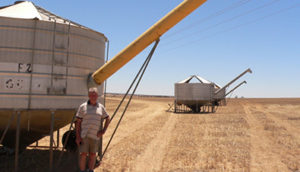Read the latest information on
Foot-and-mouth disease
 West Australian farmer Ron Creagh was a finalist in the plant category of the 2013 Biosecurity Farmer of the Year Award.
West Australian farmer Ron Creagh was a finalist in the plant category of the 2013 Biosecurity Farmer of the Year Award.
Ron, with his wife Robyn and son Kim farm 13,000 hectares in the low rainfall shires of Trayning and Nungarin in the central wheat belt of Western Australia.
It’s a family business, established by Ron’s grandparents in 1909, that has celebrated over 100 years of agriculture.
Typically the Creaghs crop 10,000 hectares, mainly wheat and smaller amounts of canola, barley and lupins. They also run a self-replacing flock of 4,000 Merino ewes and shear about 8,000 sheep. The flock has had Dohne bloodlines incorporated into it to help enhance the flock for meat production.
As a grain grower Ron sees biosecurity as both a good business and a good farming practice that is imperative to the overall success of his farming business.
“It is a practice that begins at the farm-gate and plays a major part in my cropping program. The management of people and product onto the property have high priority,” said Ron.
Ron Creagh’s interest in biosecurity goes back to the late 1960’s. He experienced the devastation of a foot and mouth disease outbreak in the UK, an incident that horrified him. This experience brought home to Ron the importance of good farm biosecurity practice.
While he sees that there can be savings in farmer to farmer trading of seed to upgrade varieties, Ron maintains that you should not source your seed requirements from outside of the farm except through certified sellers.
This in part comes from a time when he was a registered seed grower.
“I was astounded at how many growers came to collect seed, with only a few asking for seed certification notices,” he said.
Similarly, Ron will only purchase livestock from a reputable supplier or breeder.
“Newly acquired livestock are isolated as a form of farm-based quarantine before being introduced onto the farm properly,” he said.
Erecting a simple biosecurity sign is something all growers can do to help manage people movement on their farm.
“The mobility of people now in the farming industry is a cause for concern. The employment of seasonal labour into the district sees visitors and workers coming in from places like the UK and New Zealand,” he said.
Ron’s commitment to biosecurity extends beyond his own property. He has been on the Agriculture Protection Board of WA since the mid-1990s.
After the outbreak of lupin anthracnose in 1996 he became an inaugural member of the Grain Guard program, served as Grain Guard inaugural chairman and was responsible for drafting industry incursion plans for all grain commodities in WA.
He has been a member of the Biosecurity Council of WA and Grain Industry Association of WA (GIWA), and recently returned to the Grain Guard committee as a GIWA representative.
Ron was appointed to the Grains, Seed and Hay Industry Funding Scheme Management Committee that manages the skeleton weed program and pest incursions of the grain industry in WA.